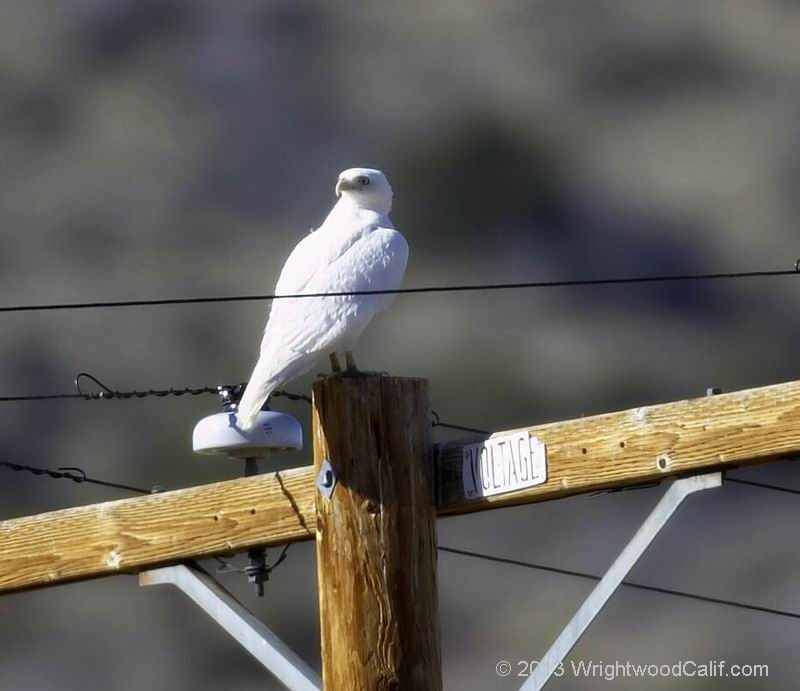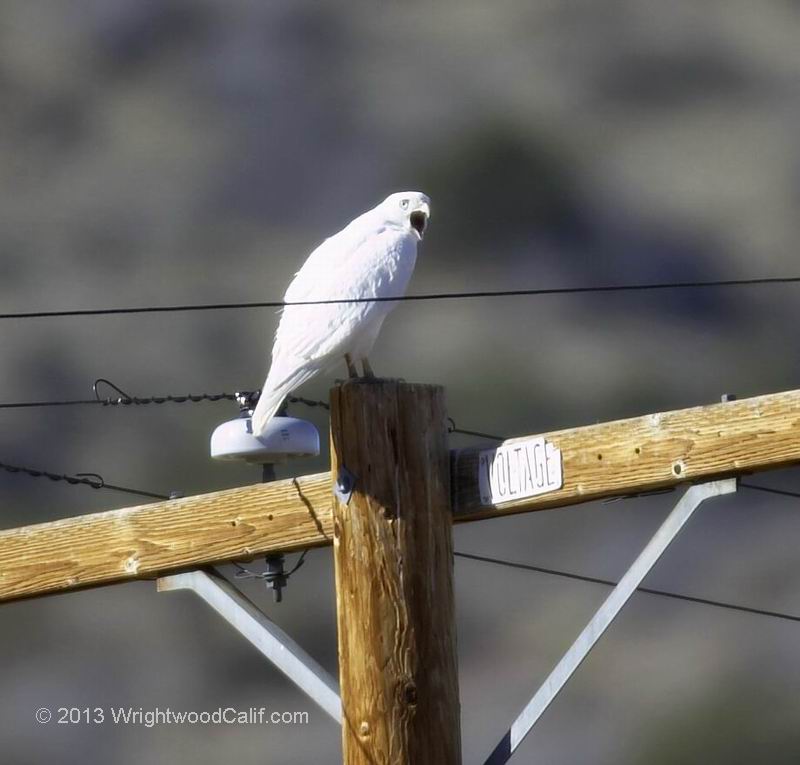In January I was very fortunate to hear about a rare bird in the Valyermo area and capture some photos of this all white Red Tail Hawk.
A few questions and answers with raptor expert Bill Clark about this particular Red Tail Hawk:
Q What are the characteristics that indicate it's a juvenile?
A The pale yellow eye color. Adults have dark brown eyes.
Q Is it possible to tell if it's male or female?
A No.





Here's some additional information I found:
Leucism (pronounced loo-kism) is a genetic condition in which an animal displays reduced skin or scale pigmentation. Unlike albinos, leucistic (loo-kiss-tic) animals have normally colored eyes, while true albinos have pink eyes.
http://www.birds.cornell.edu/pfw/AboutBirdsandFeeding/Albinism_Leucism.htmhttp://www.timesrepublican.com/page/content.detail/id/545768/Unique-white-Red-Tailed-Hawk-in-area.html?nav=5127
http://www.sibleyguides.com/2011/08/abnormal-coloration-in-birds-melanin-reduction/
http://raptors.hancockwildlife.org/staticpages/index.php?page=pg_0052Unique white Red-Tailed Hawk in area
January 7, 2012
By GARRY BRANDENBURG , Times-Republican
LEUCISM is the name biologists have given to the unusual condition for bird's plumage being white or mostly white. When birding folks identify birds, it is primarily by body size, shape and plumage coloration that are the first clues to solving the riddle. When a bird is all white, but looks in form and function as its normal flock members, it will gain extra attention. So it is with this hawk in the Marshalltown area. It is white. But it is not an albino.
This scribe observed what may be the same white hawk last year near Riverview Cemetery. When it eventually flew, its tail top had a very faint or faded reddish tint. Thus my identification was Red-tailed Hawk. Since then, others have seen it too. Then in late December 2011, it was seen again but this time the call went out to a photographer, Mark George, to grab a big lens and report to duty on Sixth Avenue. The result is today's feature critter photo for all of you to enjoy.
Leucism can be partial or total. In some cases, there may be patches of white among normal feathers. Sometimes the white is in patterns or as in this case, all white everywhere. Take note that there is a big difference between leucism and albinism, the former affects just the feathers. The latter affects all pigments of true albinos including skin and eyes. It is usually expressed as pink or reddish eye color, legs and feet.
An all white (not albino) Red-tailed Hawk posed for Marshalltown photographer Mark George recently. The photo was made near Sixth Avenue in Marshalltown.The trees within Riverview Cemetery are places where it has also been observed. White plumage is called leucism, and is an abnormal genetic mutation that prevents pigment, particularly melanin, from being properly deposited during feather growth.
Red-Tailed Hawks are one of our most common birds of prey. They are year round residents but we will get this raptor in the winter from parts of its breeding range in southern Canada. Once spring breaks, these birds will disperse again to the northlands. So it is not a true migration in one sense, just a temporary move to avoid deep snow and low food supplies.
Concerning snow, a white red-tail might have an advantage in catching prey if the ground was covered with snow. A big white body is less visible when all of its surroundings are white. Snowy owls are normally white and this trait allows them to approach lemmings with great stealth. If snow is on the ground, area fox or coyote hunters wear white for the same purpose, to blend into the background environment.
The opposite of all white is all black. This biological condition is seen from time to time in white-tailed deer, raccoons, or even wild turkeys. Case in point was a story in the June 2010 issue of Turkey Country magazine, and again in the February 2012 issue, where a short story on Black Beauties is told. According to biologists with the National Wild Turkey Federation, melanistic wild turkeys happen in about 1 for each 5,000 birds.
Wildlife biology always has an interesting twist to it. We observe the usual normal coloration in mammals, reptiles and avian critters. Then Mother Nature periodically throws a wrinkle into the mix, perhaps to check on us humans to see if we are paying attention. May we always pay attention to biology. May we never give up our human inquisitive nature to observe, learn, share and find out what the facts are as myths and rumors are squelched.